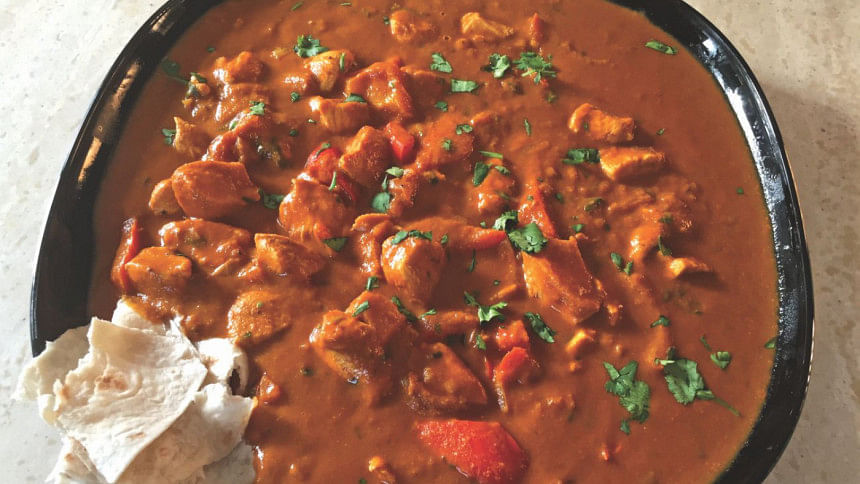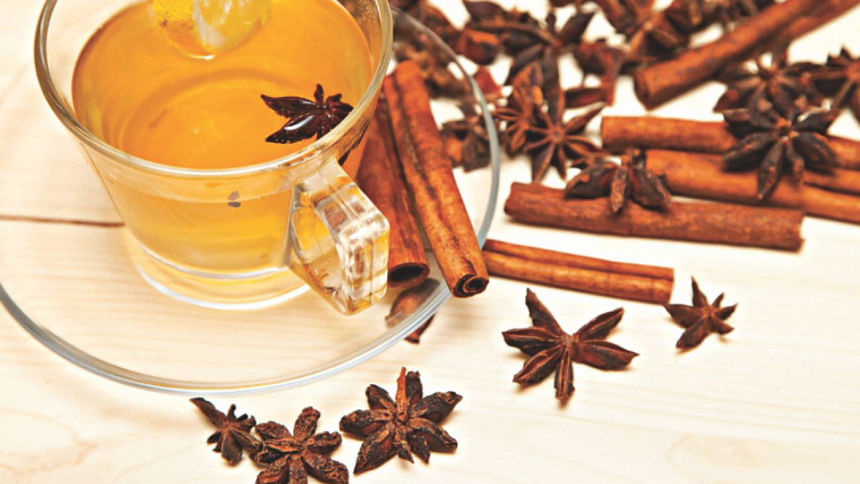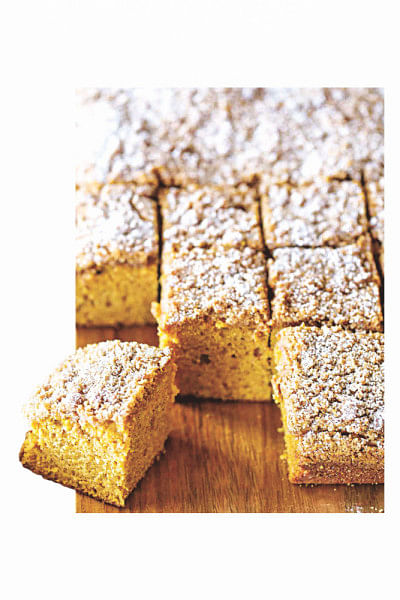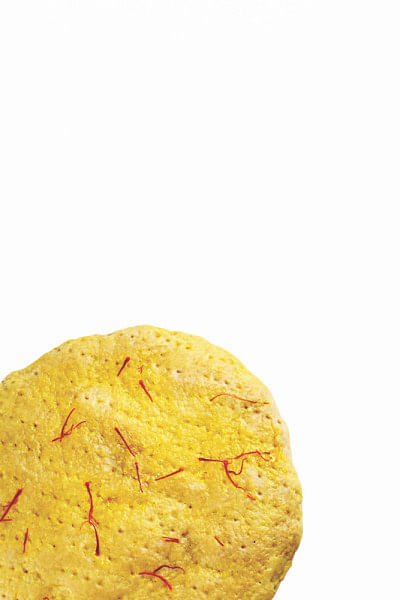Not so ordinary cooking with spices

The queen of spices
Saffron is one of the most sought after spices in the world. The threadlike ingredient that imparts a yellow hue are quite literally, imbibed in myths and legends.
What exactly is saffron anyway?
The spice originates from a flower, the sativus, or more commonly known as the 'saffron crocus.' Each flower blooms for only a week every year, and produces just three stigmas.
To protect the delicate strand that is to become saffron, the stigma has to be hand-plucked early in the morning when the petals are closed, and have not opened up to the light.
It takes about a thousand flowers to produce just a single ounce, and that is one of the reasons why the famed saffron is one of the most expensive spices in the world.
Saffron imparts a signature fragrance; a sweet, luxurious taste —almost indescribable, but one that is picked by the senses. Its birthplace is debated, but it is now available across the whole world, and is used in a wide variety of cuisines.
Preservation
It is a widely held belief that saffron does not go bad. True as it may be, prolonged storage will make it gradually lose its flavour. A few precautions can buy you some time —
Trap the saffron threads in foil and place them in an airtight container. Store them in a cool, dry, and dark place (this way they can be preserved for up to six months). Keeping a container of saffron in your freezer can keep it fresh for a much longer time.
Ground saffron should be used within 3 to 6 months and always be stored in airtight containers, in cool, dark places.
Saffron water can be stored in the fridge in an airtight container for up to three weeks.
How to crush and soak the threads
The use of saffron is a delicate culinary art and to reap the full flavour, it is advised that it is first crushed, and then soaked in water. Depending on the dish you are about to prepare, you may also chose to steep the crushed saffron in warm water, stock, milk or white wine (if you prefer) for 20 to 30 minutes. If there is any liquid in your recipe, use a small amount of the specified liquid from the instructions.
Add the saffron soaked in liquid directly to your recipe when called for.
Toasting the threads
Toasting is another common way to prepare saffron, and it's especially common for traditional recipes. Simply place a cast iron skillet on the stove over medium heat. Add the threads to the hot skillet. Cook, stirring frequently, for one minute on low heat.
Wait till they give off a strong aroma, but it cannot continue till they burn. Cool slightly, and grind the toasted saffron threads using a mortar and pestle. This powder can be soaked or added directly to the recipe.
Health facts —
Saffron, in about 100g of its quantity, contains 310 kilocalories, 65.37g of carbohydrates, 11.43g of protein, and 5.85g of fat with other minerals like calcium, copper, iron, magnesium etc. Saffron is a wonderful treatment for colds and coughs, stomach issues, uterine bleeding, insomnia, and even heart disease. It is extremely rich in manganese, which helps regulate blood sugar and aids the formation of bones, tissues, and sex hormones. Saffron also contains vitamin C, which fights infections and aids iron absorption.
Even saffron milk has great things to offer.
This spice, when combined with milk, can improve digestion and increase appetite, and help maintain healthy skin.
Drinking saffron milk every day, especially before going to bed, can promote sound sleep. Saffron oil can make your skin glow; even saffron water has amazing properties.
Sheermal (saffron flavoured naan)
Sheermal is a mildly-sweet, flavoured naan, popular in the sub-continent. While this Mughal delight is traditionally prepared in a tandoor, it can also be conveniently prepared in a tava or skillet.
Using warm milk and spices in the dough makes it rich in taste, which makes saffron flavoured naan an ideal companion to any main course, or even a snack with evening tea.
Do not forget to brush the sheermal with a little ghee before serving, as it accentuates the aroma manifold.
Ingredients
¼ tsp saffron strands
1½ cups plain flour
¼ cup ghee
1 tsp sugar
1 tsp baking powder
½ tsp cardamom powder
Salt to taste
½ cup milk
Plain flour for rolling
Ghee for brushing
Method
Combine the saffron and 1 tablespoon of hot water in a small bowl, mix well and keep aside. Combine the plain flour, ghee, sugar, baking powder, cardamom powder, saffron-water mixture and salt in a deep bowl and knead into a soft dough using milk.
Cover the dough with a wet muslin cloth and keep aside for 30 minutes. Divide the dough into 10 equal portions. Roll a portion of the dough into 100mm (4") diameter thick circle using a little plain flour for rolling.
Heat a non-stick tava and place the sheermal over it and cook it on one side till it puffs slightly and then turn over. Cook it on the other side till it puffs a little and then roast it on an open flame till it turns golden brown on both sides.
Repeat to make 9 more sheermal. Brush each sheermal with little ghee and serve immediately.

Star anise
Star anise is the dried, star shaped fruit of lllicium verum. This pretty, star shaped spice has an intensely sweet liquorice taste and smell, offering a notable counter point of flavour. The five spice powder mix, common in China, contains star anise. It is used to flavour vegetables, and to marinate meat.
It is used as a condiment for flavouring curries, confectionaries, spirits, and pickles. It is also used in perfumery.
Health facts —
Star anise is rich in antioxidants and vitamin A and C, which help fight early ageing and diabetes.
It also helps improve digestion, alleviate cramps, and reduce nausea.
Star anise tea
Consuming star anise tea after meals help treat digestive ailments such as bloating, gas, and indignation. Anise is also one of the main ingredients in masala tea.
Ingredients
3 cups water
2 tsp anise seeds
2 inch cinnamon sticks
½ tsp sugar
1½ tbsp lemon juice
2 tbsp honey
2 black tea bags
Method
In a small saucepan, combine all the ingredients except tea bags, and bring to a boil and strain. Pour liquid into serving cups with one tea bag and allow it to steep for three minutes or to desired strength. Serve hot.

Naga chilli
The naga chilli, locally known as naga morich, is a chilli pepper cultivated in Bangladesh and Northeast India. It is one of the hottest known chilli peppers, and is closely related to the Bhut Jolokia.
Many specialists agree that the Naga chilli is as spicy as Refi and like Bhut Jolokia (ghost pepper), it has a sweet and slightly tart flavour, followed by slight undertones of woody, smoky flavours.
Naga Bhut Jolokia Chicken Curry
Ingredients
1 Naga chilli
6 green chillies, finely chopped
4 large chicken breasts, sliced into pieces
1 tsp ground cumin
3 onions, finely chopped
3 tbsp oil
4 large tomatoes, roughly chopped
1 tsp garam masala
1 tbsp ground ginger
1 tsp turmeric
3 cups water
2 tbsp salt
3 tbsp yoghurt
1 tbsp ground coriander
Method
Heat oil in a large pan over medium heat and add cumin. When heated, add onions. Fry for 3 minutes. Add the Naga chilli, green chillies, turmeric, ginger and garlic. Cook for 3-4 minutes. Add the tomatoes and the yoghurt. Stir and mix well.
Add chicken, salt and stir well. Fry for a few minutes. Add water and garam masala powder. Cover and cook for another 10 minutes. When done remove from heat and serve hot.

Pumpkin Spice Cake
Ingredients
1¾ cups whole wheat flour
1 cup brown sugar
½ tsp salt, ½ tsp baking soda
¼ tsp baking powder
1 tsp ground ginger
½ tsp ground cinnamon
½ tsp ground nutmeg
1 tsp vanilla extract
6 tbsp butter
1 cup pumpkin purée
½ cup milk or water
1 cup raisins, walnuts or cashew nuts
Method
Preheat the oven to 350°F. Lightly grease an 8-inch square or 9-inch round pan. In a large bowl, whisk together the flour, brown sugar, salt, baking soda, baking powder and spices. In a medium bowl, whisk together the vanilla, butter, pumpkin purée and water or milk. Stir the ingredients until evenly moistened.
Mix in the raisins, walnuts or cashew nuts. Transfer the batter to the prepared pan. Bake the cake for 30-35 minutes. Remove the cake from the oven and serve it warm from the pan, garnished with confectioners' sugar if desired. Cool completely, and store any leftovers, well wrapped, at room temperature for several days, or freeze for longer storage.
Photo: Collected

 For all latest news, follow The Daily Star's Google News channel.
For all latest news, follow The Daily Star's Google News channel. 



Comments